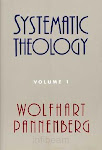Theology of Art, Part I
Hands and Brains (or Lack of)
Hands and Brains (or Lack of) (continued)
Theology of Art, Part II
The Body - Neither Puritanism nor Pornography
The Body - Neither Puritanism nor Pornography (continued)
Theology of Art, Part III
Nakedness and imago Dei
Nakedness and imago Dei (continued)
- - - - - - - - - - - - - - - - - - - - -
Nakedness and Imago Dei(
continued)
"God is love," wrote John (1 Jn. 4:8). The doctrine of the Trinity sheds light on this mystery of love: love requires a lover (the Father), a beloved (the Son, who responds to the Father's love), and the bond of love itself (the Holy Spirit). Christ too further illuminates the mystery of love: he loved
freely (Jn. 10:18),
perfectly and totally (Jn. 13:1b),
faithfully "to the end" (Mt. 28:20b), and
fruitfully (Jn. 10:10b).
According to John Paul II, we are
called to love according to this example, which God himself has set for us in Christ, the Archetype of the image of God in us. And this "call to love" - here comes the point - is
stamped in our bodies as well.
Adam and Eve certainly knew this. They looked at each other with "all the peace of the interior gaze," as the pope semi-poetically expresses it. After the fall, God's image, our call to love, was stained. Our forefathers "were ashamed" and covered themselves with "fig leaves" (Gen. 3:1-11). Why?
We could likewise ask: Why does a woman instinctively cover her naked body in the presence of a man (sometimes even her own husband)?
What is shame? John Paull II says it is fear. Shame is a defense mechanism against the "lustful look". After the fall, the distortion of sexual desire - lust - objectifies the body. Lust treats the body as an "instrument" and neither sees nor respects its image of God. The other is not respected as a person.
"But
from the beginning it was not so," Christ used to say (Mt. 19:3-9). With these words, he
confirmed having reopened the path to God's original plan for human sexuality. Christ restores us to original purity. Our innermost life, our
heart, can be renewed through grace working in us and with us.
Christ allowed (without experiencing lust) an attractive woman to wash his feet with her tears and dry them with her hair. He saw a wounded woman who longed for her True Love (which was Christ himself, whether she knew it or not).
Christian purity allows the admiration of the naked body in art (and in general) - it sees in the body the call for self-giving love (
agape). Christian purity can call a chapel saturated with naked frescoes the "sanctuary of the theology of the body" - it sees in the chapel a symphony of praise to God's original plan for human sexuality.
One last note. I said "Christian purity can", not "Christians can". The latter depends on how far a person has progress in the renewal of his heart. If you recoiled at what has been said here, ask yourself why.
(
end of part III)









